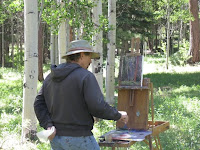
The star if this little demo is the "Brown" bag.
What color is a brown bag? What color is BROWN.
When seeing neutrals the temptation is to give them the generic title of BROWN or GREY. But how does that play out in the mixing?
The limited palette we use in class has 2 yellows, 2 reds and 2 blues;
mix those primary colors together to create orange, green and violet. So where is BROWN on that darn color wheel.
BROWNs, GREYs - and all neutrals must have some color base.
Is it cool, meaning green, blue or violet based?
Or is it warm, meaning yellow, orange or red based?
To me the BROWN bag seemed "yellow". At least yellow described it better than any other color in the color wheel.
With yellow as my base, at least I know where to start mixing. But HOW do I get BROWN?
Another way to say it would be: How do I get that neutral version of yellow? Gee, I thought you'd never ask.
Mix yellow with its complement- VIOLET!
In the end, or should I say, in the beginning - every neutral starts with a color base. Pick a color on the color wheel that most resembles the neutral you want to mix; then begin to "neutralize" that color with the complement - the color directly across the color wheel.
Viola! Brown; and not just any BROWN, but a neutral golden yellow that makes the little bag sing.

 Margaret Jones here, is intent at mixing and behind her is Dee Bartee. This area has enough material to keep us entertained for years; a pond, a river, waterfalls, tall pine forests, distant canyon walls and deep aspen forests. The only part I don't like about this place is leaving. Thanks Josie, for being such a great hostess.
Margaret Jones here, is intent at mixing and behind her is Dee Bartee. This area has enough material to keep us entertained for years; a pond, a river, waterfalls, tall pine forests, distant canyon walls and deep aspen forests. The only part I don't like about this place is leaving. Thanks Josie, for being such a great hostess.






